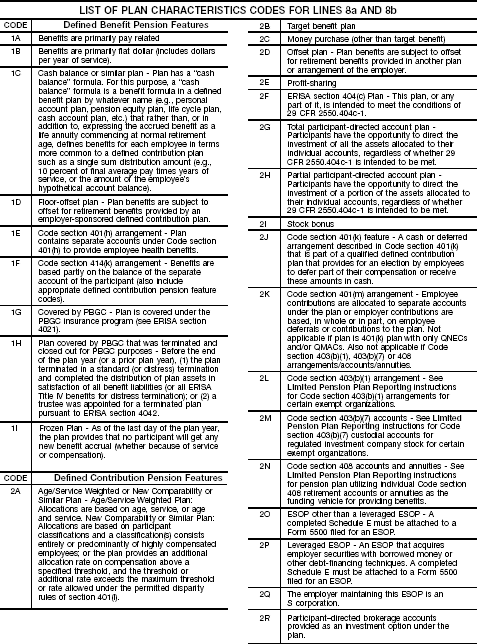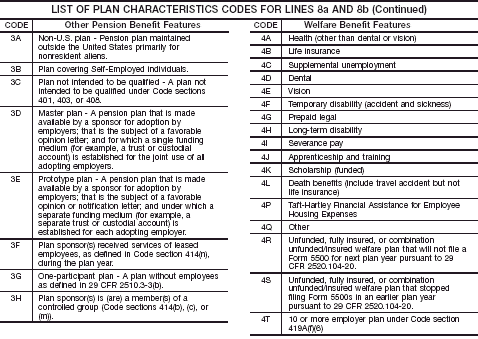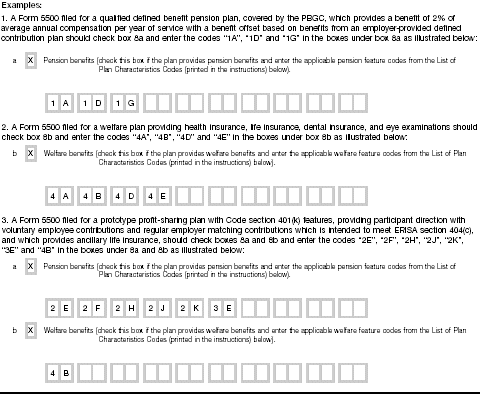Part II - Basic Plan Information
Line 1a. Enter the formal name of the plan or DFE or enough information to identify the plan or DFE. Abbreviate if necessary.
Line 1b. Enter the three-digit plan or entity number (PN) the employer or plan administrator assigned to the plan or DFE. This three-digit number, in conjunction with the employer identification number (EIN) entered on line 2b, is used by the IRS, DOL, and PBGC as a unique 12-digit number to identify the plan or DFE.
Start at 001 for plans providing pension benefits or DFEs as illustrated in the table below. Start at 501 for welfare plans and GIAs. Do not use 888 or 999.
Once you use a plan or DFE number, continue to use it for that plan or DFE on all future filings with the IRS, DOL, and PBGC. Do not use it for any other plan or DFE, even if the first plan or DFE is terminated.
For
each Form 5500 with the same EIN (line 2b), when 
|
Assign PN 
|
| Part
II, box 8a is checked, or Part I, A(4) is checked and
an M, C, P, or E is entered |
001 to the first plan or DFE. Consecutively number others as 002, 003. . .
|
| Part
II, box 8b is checked and 8a is not checked, or Part I,
A(4) is checked and a G is entered |
501 to the first plan or GIA. Consecutively number others as 502, 503. . .
|
Exception. If Part II, box 8a is checked and 333 (or a higher number in a sequence beginning with 333) was previously assigned to the plan, that number may be entered on line 1b.
Line 1c. Enter the date the plan first became effective.
Line 2a. Each row of boxes on the hand print forms is designed to contain specific information regarding the plan sponsor. Please limit your response to the information required in each row of boxes as specified below:
- Enter in the first two rows of boxes labeled 1) the name of the plan sponsor or, in the case of a Form 5500 filed for a DFE, the name of the insurance company, financial institution or other sponsor of the DFE (e.g., in the case of a GIA, the trust or other entity that holds the insurance contract or in the case of an MTIA, one of the sponsoring employers). If the plan covers only the employees of one employer, enter the employer's name.
The term "plan sponsor" means:
- The employer, for an employee benefit plan that a single employer established or maintains;
- The employee organization in the case of a plan of an employee organization; or
- The association, committee, joint board of trustees, or other similar group of representatives of the parties who establish or maintain the plan, if the plan is established or maintained jointly by one or more employers and one or more employee organizations, or by two or more employers.
Note. In the case of a multiple-employer plan, if an association or similar entity is not the sponsor, enter the name of a participating employer as sponsor. A plan of a controlled group of corporations should enter the name of one of the sponsoring members. In either case, the same name must be used in all subsequent filings of the Form 5500 for the multiple-employer plan or controlled group (see instructions to line 4 concerning change in sponsorship).
- Enter in row 2) any "in care of (C/O)" name.
- Enter in row 3) the street address. A post office box number may be entered if the Post Office does not deliver mail to the sponsor's street address.
- Enter in row 4) the name of the city.
- Enter in row 5) the two-character abbreviation of the U.S. state or possession and zip code.
- Enter in row 6) the foreign routing code, if applicable. Leave row 5), U.S. state and zip code, blank if entering information in rows 6) and 7).
- Enter in row 7) the foreign country, if applicable.
- Enter in row 8) the "doing business as (D/B/A)" or trade name of the sponsor if different from the name entered in 1).
- Enter in the rows of boxes labeled 9) any second address. Use only a street address, not a P.O. box, here. A P.O. box may be entered only in row 3).
Line 2b. Enter the nine-digit employer identification number (EIN) assigned to the plan sponsor/employer. For example, 00-1234567. In the case of a DFE, enter the EIN assigned to the CCT, PSA, MTIA, 103-12 IE, or GIA.
Employers, plan administrators and DFEs who do not have an EIN should apply for one on Form SS-4, Application for Employer Identification Number, as soon as possible. You can obtain Form SS-4 by calling 1-800-TAX-FORM (1-800-829-3676) or at the IRS Web Site at www.irs.gov. The PWBA does not issue EINs.
A multiple-employer plan or plan of a controlled group of corporations should use the EIN of the sponsor identified in line 2a. The EIN must be used in all subsequent filings of the Form 5500 for these plans (see instructions to line 4 concerning change in EIN).
If the plan sponsor is a group of individuals, get a single EIN for the group. When you apply for a number, enter on line 1 of Form SS-4 the name of the group, such as "Joint Board of Trustees of the Local 187 Machinists' Retirement Plan." EINs may be obtained by filing Form SS-4 as explained above.
Note. EINs for funds (trusts or custodial accounts) associated with plans (other than DFEs) are generally not required to be furnished on the Form 5500; the IRS will issue EINs for such funds for other reporting purposes. EINs may be obtained by filing Form SS-4 as explained above. Plan sponsors should use the trust EIN described above when opening a bank account or conducting other transactions for a trust that require an EIN.
Line 2d. Enter the six-digit business code that best describes the nature of the plan sponsor's business from the list of business codes on pages 59, 60, and 61. If more than one employer or employee organization is involved, enter the business code for the main business activity of the employers and/or employee organizations.
Line 3a. Each row of boxes on the hand print forms is designed to contain specific information regarding the plan administrator. Please limit your response to the information required in each row of boxes as specified below:
- Enter in the first two rows of boxes labeled 1) the name of the plan administrator unless the administrator is the sponsor identified in line 2 or the Form 5500 is submitted for a DFE (Part I, box A(4) should be checked). If this is the case, enter the word "same" on line 3a and leave the remainder of line 3a, and all of lines 3b and 3c blank.
Plan administrator means:
- The person or group of persons specified as the administrator by the instrument under which the plan is operated;
- The plan sponsor/employer if an administrator is not so designated; or
- Any other person prescribed by regulations if an administrator is not designated and a plan sponsor cannot be identified.
- Enter in row 2) any "in care of (C/O)" name.
- Enter in row 3) the street address. A post office box number may be entered if the Post Office does not deliver mail to the administrator's street address.
- Enter in row 4) the name of the city.
- Enter in row 5) the two-character abbreviation of the U.S. state or possession and zip code.
- Enter in rows 6) and 7) the foreign routing code and foreign country, if applicable. Leave row 5), U.S. state and zip code, blank if entering information in rows 6) and 7).
Line 3b. Enter the plan administrator's nine-digit EIN. A plan administrator must have an EIN for Form 5500 reporting purposes. If the plan administrator does not have an EIN, apply for one as explained in the instructions for line 2b. One EIN should be entered for a group of individuals who are, collectively, the plan administrator.
Note. Employees of the plan sponsor who perform administrative functions for the plan are generally not the plan administrator unless specifically designated in the plan document. If an employee of the plan sponsor is designated as the plan administrator, that employee must get an EIN.
Line 4. If the plan sponsor's or DFE's name and/or EIN have changed since the last return/report was filed for this plan or DFE, enter the plan sponsor's or DFE's name, EIN, and the plan number as it appeared on the last return/report filed.
Line 5. (Optional) You may use this line to designate the person or entity that is principally responsible for the preparation of the annual return/report.
Line 5a. Each row of boxes on the hand print forms is designed to contain specific information regarding the preparer. Please limit your response to the information required in each row of boxes as specified below:
- If the person who prepared the annual return/report is not the employer named in line 2a or the plan administrator named in line 3a, you may name the person in the first two rows of boxes labeled 1).
- Enter in row 2) the street address. If the Post Office does not deliver mail to the street address and the preparer has a P.O. box, enter the box number.
- Enter in row 3) the name of the city.
- Enter in row 4) the two-character abbreviation of the U.S. state or possession and zip code.
- Enter in rows 5) and 6) the foreign routing code and foreign country, if applicable. Leave row 4), U.S. state and zip code, blank if entering information in rows 5) and 6).
Lines 6 and 7. All filers must complete both lines 6 and 7 unless the Form 5500 is filed for a 403(b) Arrangement or IRA Plan eligible for Limited Pension Plan Reporting as described on page 8 or for a DFE.
The description of "participant" in the instructions below is only for purposes of these lines.
For welfare plans, the number of participants should be determined by reference to 29 CFR 2510.3-3(d). Dependents are considered neither participants nor beneficiaries. A child who is an "alternate recipient" entitled to health benefits under a qualified medical child support order should not be counted as a participant for lines 6 and 7. For pension benefit plans, "alternate payees" entitled to benefits under a qualified domestic relations order are not to be counted as participants for these lines.
"Participant" means any individual who is included in one of the categories below:
- Active participants include any individuals who are currently in employment covered by a plan and who are earning or retaining credited service under a plan. This category includes any individuals who are eligible to elect to have the employer make payments to a Code section 401(k) qualified cash or deferred arrangement. Active participants also include any nonvested individuals who are earning or retaining credited service under a plan. This category does not include
- nonvested former employees who have incurred the break in service period specified in the plan or
- former employees who have received a "cash-out" distribution or deemed distribution of their entire nonforfeitable accrued benefit.
- Retired or separated participants receiving benefits are any individuals who are retired or separated from employment covered by the plan and who are receiving benefits under the plan. This includes former employees who are receiving group health continuation coverage benefits pursuant to Part 6 of ERISA and who are covered by the employee welfare benefit plan. This category does not include any individual to whom an insurance company has made an irrevocable commitment to pay all the benefits to which the individual is entitled under the plan.
- Other retired or separated participants entitled to future benefits are any individuals who are retired or separated from employment covered by the plan and who are entitled to begin receiving benefits under the plan in the future. This category does not include any individual to whom an insurance company has made an irrevocable commitment to pay all the benefits to which the individual is entitled under the plan.
- Deceased individuals who had one or more beneficiaries who are receiving or are entitled to receive benefits under the plan. This category does not include an individual if an insurance company has made an irrevocable commitment to pay all the benefits to which the beneficiaries of that individual are entitled under the plan.
Line 7g. Enter the number of participants included on line 7f (total participants at the end of the plan year) who have account balances. For example, for a Code section 401(k) plan the number entered on line 7g should be the number of participants counted on line 7f who have made a contribution to the plan for this plan year or any prior plan year. Defined benefit plans should leave line 7g blank.
Line 7h. Include any individual who terminated employment during this plan year, whether or not he or she
- incurred a break in service,
- received an irrevocable commitment from an insurance company to pay all the benefits to which he or she is entitled under the plan, and/or
- received a cash distribution or deemed cash distribution of his or her nonforfeitable accrued benefit. Multiemployer plans and multiple-employer plans that are collectively bargained do not have to complete line 7h.
Line 7i. If a number is entered on line 7i, you must file Schedule SSA (Form 5500) as an attachment to the Form 5500.
 Code section 6057(e) provides that the plan administrator must give each participant a statement showing the same information reported on Schedule SSA for that participant.
Code section 6057(e) provides that the plan administrator must give each participant a statement showing the same information reported on Schedule SSA for that participant.
Line 8 - Benefits Provided Under the Plan. Check 8a and/or 8b, as appropriate. In addition, enter in the boxes provided all applicable plan characteristic codes from the table on pages 17 and 18 that describe the characteristics of the plan being reported. (See examples on page 19.)
Line 9 - Funding and Benefit Arrangements. Check all boxes that apply to indicate the funding and benefit arrangements used during the plan year. The "funding arrangement" is the method for the receipt, holding, investment, and transmittal of plan assets prior to the time the plan actually provides benefits. The "benefit arrangement" is the method by which the plan provides benefits to participants. For the purposes of line 9:
"Insurance" means the plan has an account, contract, or policy with an insurance company, insurance service, or other similar organization (such as Blue Cross, Blue Shield, or a health maintenance organization) during the plan or DFE year. (This includes investments with insurance companies such as guaranteed investment contracts (GICs).) Do not check "insurance" if the sole function of the insurance company was to provide administrative services.
"Code section 412(i) insurance contracts" are contracts that provide retirement benefits under a plan that are guaranteed by an insurance carrier. In general, such contracts must provide for level premium payments over the individual's period of participation in the plan (to retirement age), premiums must be timely paid as currently required under the contract, no rights under the contract may be subject to a security interest and no policy loans may be outstanding. If a plan is funded exclusively by the purchase of such contracts, the otherwise applicable minimum funding requirements of section 412 of the Code and section 302 of ERISA do not apply for the year and a Schedule B is not required to be filed.
"Trust" includes any fund or account that receives, holds, transmits, or invests plan assets other than an account or policy of an insurance company.
"General assets of the sponsor" means either the plan had no assets or some assets were commingled with the general assets of the plan sponsor prior to the time the plan actually provided the benefits promised.
Example. If the plan held all its assets invested in registered investment companies and other non-insurance company investments until it purchases annuities to pay out the benefits promised under the plan, box 9a(3) should be checked as the funding arrangement and box 9b(1) should be checked as the benefit arrangement.
Note. An employee benefit plan that checks boxes 9a(1), 9a(2), 9b(1), and/or 9b(2) must attach Schedule A (Form 5500), Insurance Information, to provide information concerning each contract year ending with or within the plan year. See the instructions to the Schedule A and enter the number of Schedules A on line 10b(3), if applicable.
Line 10. Check the boxes on line 10 to indicate the schedules being filed and, where applicable, count the schedules and enter the number of attached schedules in the space provided.

Plan Characteristics Code

Plan Characteristics Codes #2

Examples
Previous| First | Next
Instructions Index | 2002 Tax Help Archives | Tax Help Archives | Home
